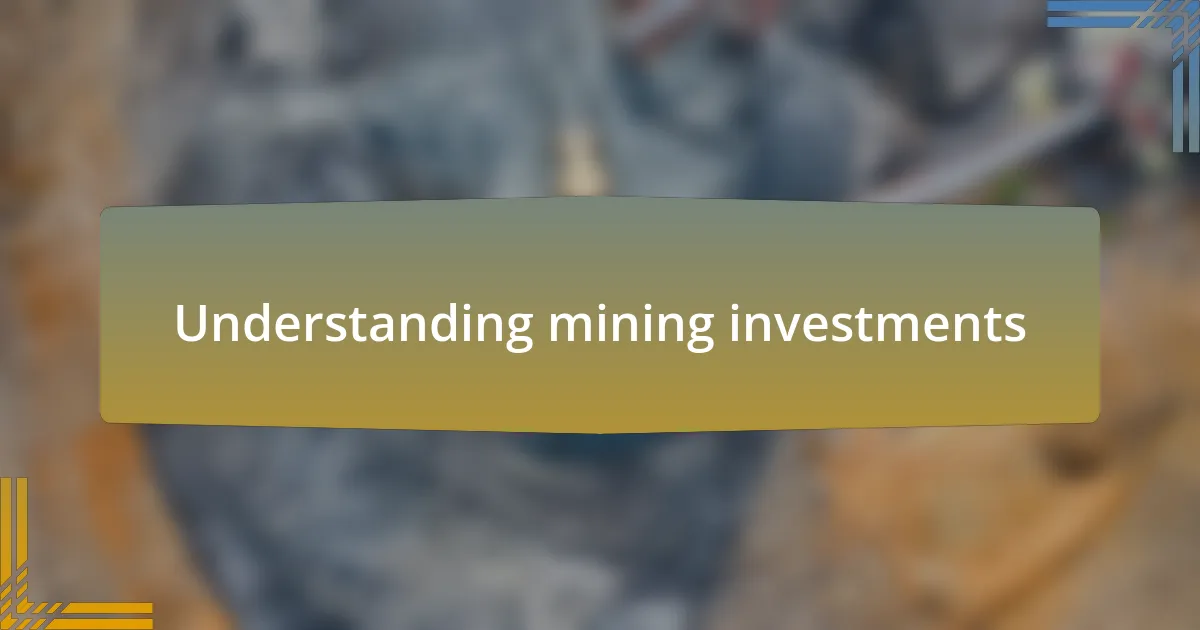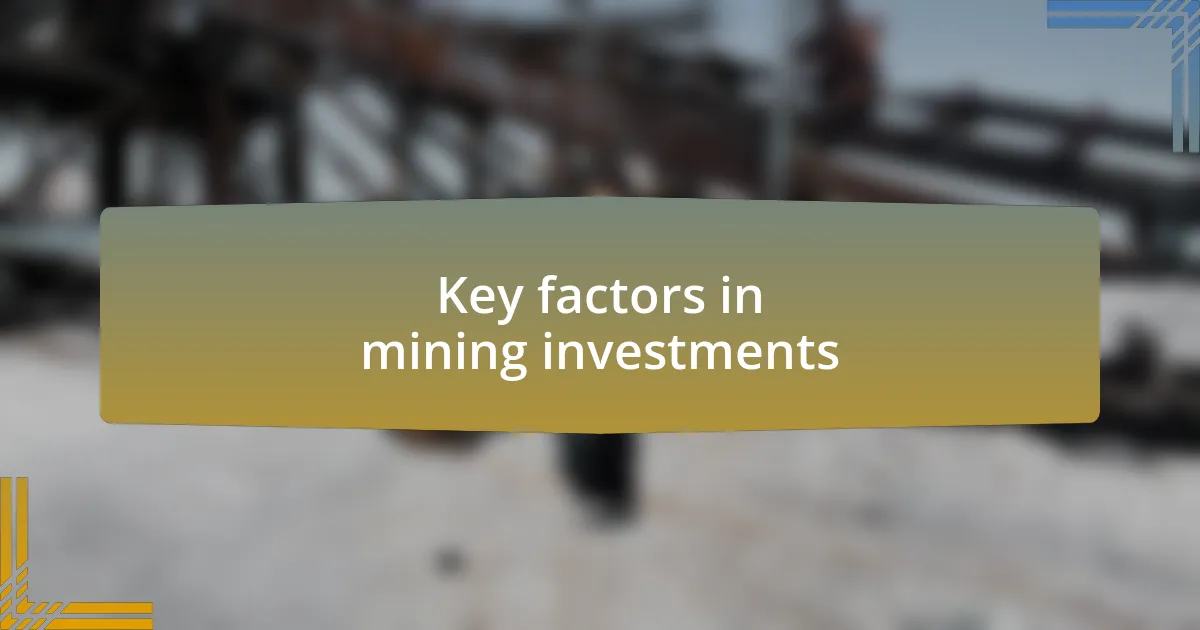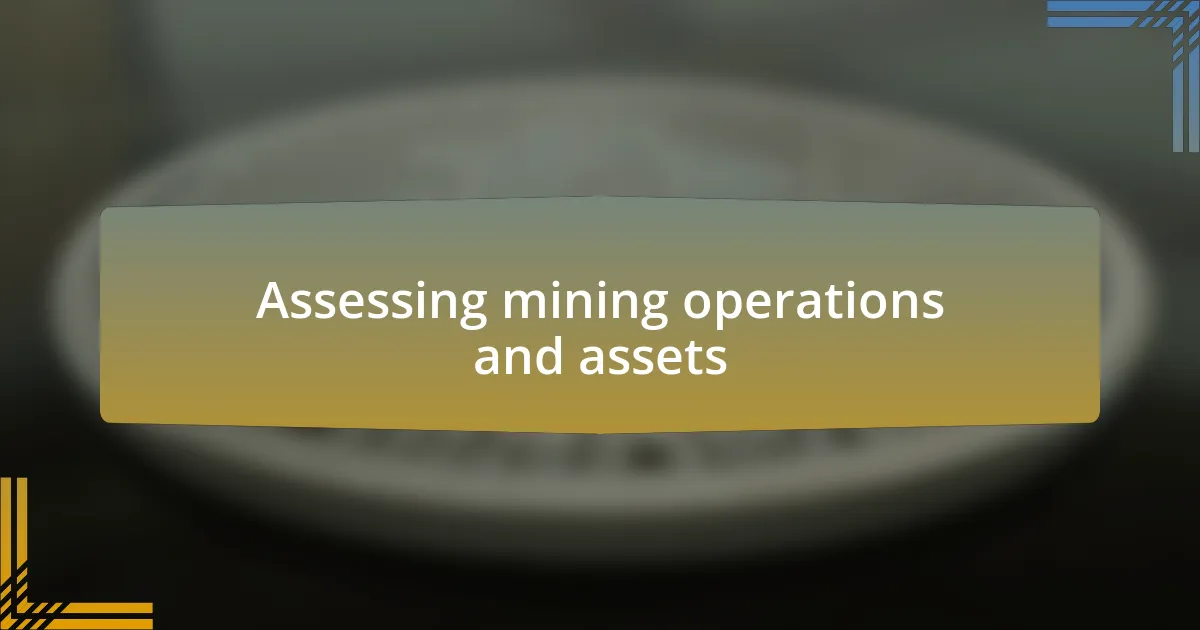Key takeaways:
- Mining investments require a deep understanding of resource value, geopolitical factors, and the management team’s competence.
- Owning mining stocks can diversify portfolios and provide a hedge against inflation, especially during economic uncertainty.
- Key factors in mining investments include project location, management quality, and the financial health of the company.
- Analyzing commodity market trends involves understanding supply and demand, seasonal fluctuations, and geopolitical influences.

Understanding mining investments
Mining investments can be a bit of a mystery for newcomers, but understanding them doesn’t have to be daunting. I remember my first foray into this sector; the sheer amount of information was overwhelming. Yet, I realized that at its core, mining investments are about understanding the value of the resources being extracted and the companies behind them. What if you could identify the next big miner before it hits the mainstream? That’s the excitement of this field.
The mining industry isn’t just about digging up minerals; it’s a complex interplay of geology, economics, and geopolitics. I often found myself marveling at how a single political event in a country can swing the price of gold or copper overnight. When I looked deeper, it became clear to me that a sharp understanding of these dynamics can make or break your investment. Have you considered how regional stability factors into your decisions?
In the realm of mining, I’ve learned that patience truly is a virtue. I once held onto a mining stock for several years, enduring market fluctuations that tested my resolve. The rewards, however, were well worth it when a breakthrough in the company’s operations finally paid off. Mining investments often require a long-term perspective; sometimes you have to dig deeper than just the surface numbers to find the true value. Do you have what it takes to see beyond the immediate trends? That’s where the potential lies.

Importance of mining stocks
Mining stocks play a crucial role in diversifying an investment portfolio. I remember speaking with an experienced investor who emphasized that owning mining stocks can hedge against inflation, especially in uncertain economic times. When commodity prices rise, these stocks often follow suit, providing a safety net. Have you ever felt anxious about your investment’s resilience during market downturns? Mining stocks can sometimes act as a buffer.
Moreover, investing in mining stocks allows individuals to tap into the lucrative demand for metals and minerals essential for modern technology and energy solutions. When I first learned about the importance of lithium for electric vehicle batteries, I was intrigued by the idea that I could be part of this innovative shift through mining investments. Have you considered how investing in these stocks not only supports your portfolio but also contributes to sustainable technology?
Another aspect of mining stocks that I find compelling is the potential for significant capital appreciation. While many investments offer slow and steady growth, mining stocks can yield explosive returns under the right conditions. I still recall my excitement when a small, lesser-known mining company I invested in announced a major discovery. The stock price skyrocketed overnight. Are you open to discovering potential gems in this volatile sector? The excitement of finding such opportunities makes mining stocks a vibrant avenue for growth.

Key factors in mining investments
Key factors in mining investments
When considering mining investments, one key factor I always assess is the project location. For instance, I remember a time when I invested in a company operating in a politically stable country with rich mineral deposits. The peace of mind that came with knowing my investment was less likely to be impacted by geopolitical risks was invaluable. Have you ever felt the stress of uncertainty? It reinforces the importance of regional stability in mining.
Another significant aspect is the management team behind the mining company. I once came across a startup with a brilliant geological vision but a weak leadership structure. Unfortunately, that investment didn’t pan out as expected. A strong, experienced team can make all the difference in navigating the complexities of mining operations. Are you paying attention to who’s at the helm of the companies you’re interested in?
Lastly, I always analyze a company’s financial health and resource reserves. During my initial foray into mining stocks, I overlooked this and realized later how critical it was. Assessing debt levels and understanding cash flow can provide insights into whether a company can sustain its operations and thrive. Have you evaluated the balance sheets of your investments lately? Sometimes, the numbers tell a story that can guide your investment decisions.

Evaluating mining company management
When evaluating mining company management, it’s essential to look for a proven track record. I once invested in a company where the CEO had previously led a failing project, and I faced significant losses. Do you think a strong history of success is a reliable indicator of future performance? I believe it often is, especially in a sector as challenging as mining, where experience can be the difference between a thriving operation and costly setbacks.
Another critical aspect is their communication style. I’ve noticed that transparent management tends to build investor confidence. In one instance, a company I followed provided regular updates during a challenging drilling phase, which reassured me they were on top of the issues. How often do you find yourself wishing for clearer communication from companies you’ve invested in? A good leader should make investors feel connected and informed, especially in an industry where updates can significantly impact stock prices.
Lastly, I pay close attention to how management responds to setbacks. During a downturn in commodity prices, I watched a company’s response closely. They made strategic adjustments rather than panic, which boosted my faith in their leadership. Have you considered how management handles adversity in your investments? To me, resilience in the face of challenges reflects strength and foresight, qualities that are incredibly valuable in mining leadership.

Assessing mining operations and assets
When assessing mining operations and assets, the quality of the site’s geology is paramount. I remember a time when I overlooked this aspect and invested in a property that was thought to be rich in minerals, only to find out it was underperforming due to poor geological assessments. Have you ever considered how a thorough geological review can alter your perception of a mining asset? Understanding the underlying geology can make all the difference in predicting a project’s potential.
Another factor to consider is the operational efficiency of the mine itself. I’ve observed that companies with advanced technology tend to have lower operating costs and higher output rates. In one particular investment, I was impressed by how a mining operation utilized automation, which not only reduced costs but also minimized safety risks for workers. Have you thought about how these efficiencies impact long-term profitability? Efficient operations can significantly boost a company’s bottom line, making them an attractive investment opportunity.
Finally, the regulatory environment surrounding mining assets can’t be ignored. I once backed a project that seemed promising, only for it to be hindered by unexpected legal hurdles. It taught me the importance of understanding local regulations and permitting processes. Have you ever factored in the risk of regulatory changes when considering mining stocks? The stability of a mining operation often hinges on its compliance and adaptability to the evolving legal landscape, which plays a crucial role in its overall success.

Analyzing commodity market trends
Analyzing commodity market trends requires a keen understanding of supply and demand dynamics. I recall tracking the shifts in gold prices during an economic downturn; it was fascinating to see how market sentiment drove investor behavior. Have you noticed how global events can influence commodity prices almost overnight? The interplay between these factors can provide valuable insights into potential investment opportunities.
In addition, seasonal trends can significantly impact commodity markets. For instance, I’ve found that agricultural commodities often fluctuate based on weather patterns and harvest cycles. Have you ever thought about how unpredictable elements like a drought or an abundant harvest can dramatically alter supply? Understanding these nuances is crucial for making informed decisions about investments in related mining sectors.
Moreover, the role of geopolitical factors cannot be overstated. I remember the anxiety I felt when tensions escalated in regions rich in rare earth metals. Such events can lead to abrupt price increases or supply shortages. Have you considered how these geopolitical stressors could affect your investment strategy? Staying attuned to international relations can help you navigate the often-volatile waters of the commodity markets, ensuring you position your portfolio wisely.

My personal criteria for selection
When I assess mining stocks, the first criterion I consider is the management team’s experience and track record. I recall investing in a company where the leadership had a history of successfully bringing projects from exploration to production. It was reassuring to see their strategic vision, which often directly influences a stock’s potential for growth. Have you ever considered how a knowledgeable management team can mitigate risks in a volatile industry?
Another key factor for me is the quality of the assets. I find it essential to evaluate the resources a mining company holds—whether it’s gold, lithium, or copper. I once overlooked a promising project due to vague resource estimates, only to watch a competitor thrive on similar terrain. It’s a stark reminder that having solid asset reserves can be a real game changer. Are you paying close attention to the geological data and feasibility studies that validate these assets?
Lastly, I tend to focus on the company’s financial health, looking closely at earnings reports and debt levels. There was a time when I invested in a miner with ambitious growth plans, only to be blindsided by unsustainable debt. This experience taught me the importance of analyzing a company’s financial position before making any commitments. How often do you scrutinize balance sheets as part of your investment strategy?